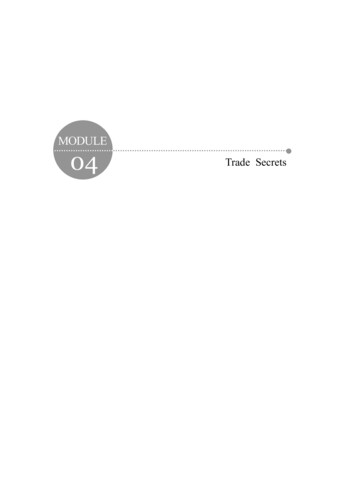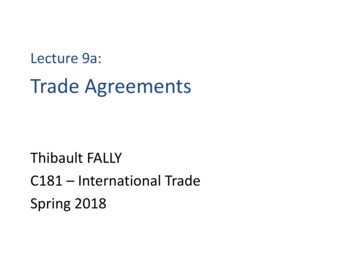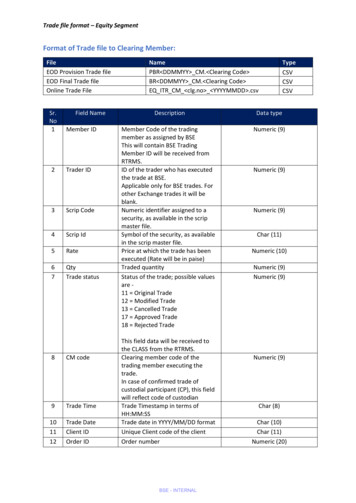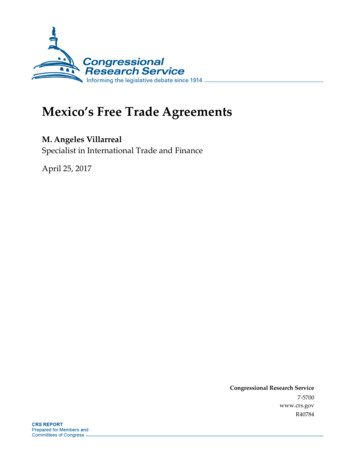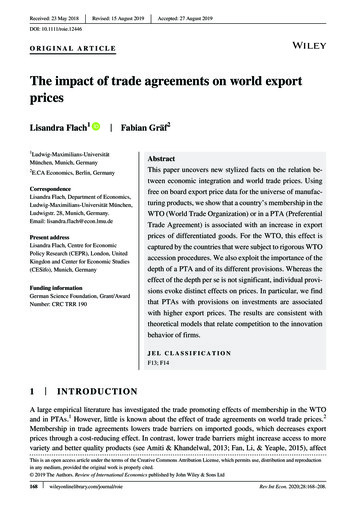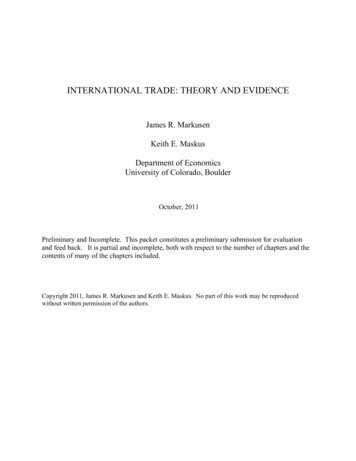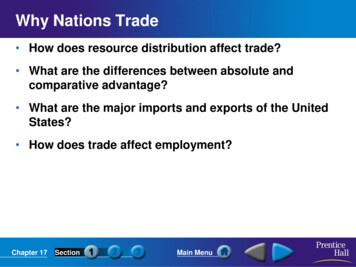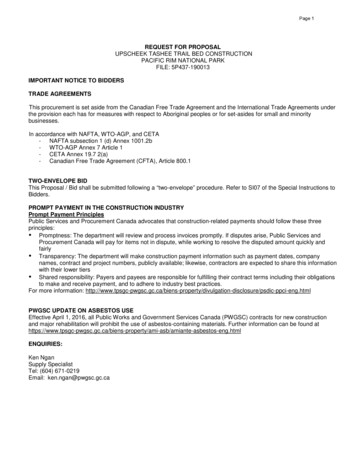
Transcription
TradeSecrets andNondisclosureAgreementsbyRichardStimMany design firms usenondisclosure agreements topreserve trade secrets. Butsimply calling informationa trade secret will not makeit so. Here's what designersneed to know to understandand protect trade secrets.1Guide to trade secrets and nondisclosure agreemenrs
1. What's a trade secret?A trade secret is “any confidential business information which provides anenterprise a competitive edge.” In order to acquire legal protection for a tradesecret—for example, to stop someone who has stolen a trade secret—theinformation must:Be a secret. The information cannot be generally known or ascertainablethrough legal methods. For example, if a procedure is already known within anindustry, it can’t be claimed to be a trade secret.2 Similarly, posting informationon the Internet, whether it is details about profit margins 3 in a company that isnot publicly traded or lists of blood donors,4 ends trade secrecy;Have value. The secret must provide the owner with some competitiveadvantage in the marketplace. One way of assessing value is to ask whethera business would be damaged if a competitor acquired the information. Forexample, when a meat packer’s secret process for freezing precooked sausagewas stolen by a competitor, a jury awarded 10.9 million in lost profits; 5 andBe treated confidentially. A designer cannot protect information as a tradesecret—even using a nondisclosure agreement—unless reasonable precautionsare taken to keep the information confidential. In general, a design businessis considered to have taken reasonable steps if it uses a sensible system forprotecting information—locking its facilities, monitoring visitors, and labelingconfidential information as “Confidential.”2. What rights does a trade secret owner have?Unlike other forms of intellectual property such as patents, copyrights, ortrademarks, trade secrecy is basically a do-it-yourself form of protection. Youdon't register with the government to secure your trade secret, you simply keepthe information confidential. Once a trade secret is made available to the public,trade secret protection ends.Like other forms of intellectual property, a trade secret can be sold (an“assignment”), it can be inherited (a family recipe turned out to be worthmillions in 2015) 6 , or it can be exploited on a temporary basis (a “license”).A trade secret owner can stop others from copying, using, and benefiting fromits trade secrets in the following situations:1234562What is a Trade Secret?.Whitmyer Bros., Inc., v. Doyle.Confederated Tribes v. Johnson.American Red Cross v. Palm Beach Blood Bank, Inc.C&F Packing Co. v. IBP, Inc.Is 3m too much for a family recipe in Singapore?.Guide to trade secrets and nondisclosure agreemenrs
Stop an employee (or former employee) from disclosing trade secrets.Under state trade secret laws, employees are automatically bound by a dutyof confidentiality and prohibited from improper disclosure of an employer’strade secrets (even without signing a nondisclosure agreement). For example,in 2014, Nike sued three former designers who had left the company, allegingthey used Nike's trade secrets for work they did for Adidas. Among the tradesecrets allegedly taken were “specific designs, including models of teamuniforms and products for the 2016 European Championships, plans forNike-sponsored athletes, unreleased financial information and projectionsconcerning the company's business and information about Nike's plannedlaunches in the marketplace”; 7Stop a trade secret thief. Anyone who acquires a trade secret through impropermeans such as theft, industrial espionage, or bribery can be halted from furtheruse and may even be subject to criminal prosecution. For example, in 2018,an Apple engineer was arrested boarding a plane for China after allegedlydownloading Apple documents containing driverless car trade secrets; 8 orStop someone who violates a nondisclosure agreement (also known as an“nda”). An nda is a contract in which one or both parties agree to maintaintrade secrets in confidence. For example, the makers of the video game Fortnitesued one of its quality assurance testers for violating his nda by disclosingfeatures of the game, which were subsequently posted on the Internet.9What Cannot Be Protected as a Trade Secret (or in an nda)?The following types of information can never be a trade secret:Independent discovery/reverseengineering. Anyone who discovers a secret legally and independently—that is, without usingillegal means or violating agreements—can use the informationwithout permission. It is not aviolation of trade secret law to disassemble and analyze (or "reverseengineer") any lawfully obtainedproduct and determine its tradesecret. For example, a designer7893may use a cad program to reverseengineer a toy design. Beware,however, some vendor contractsmay specifically prohibit reverseengineering a product.Public domain. Information ispublic domain if it has been published or publicly displayed or iscommonly used within an industry. Even a signed nda cannothelp a company claim trade secretNike sues former designers.Former Apple Engineer Reportedly Charged With Stealing AutonomousCar Secrets.Epic Games sued the leaker of Fortnite comet strike location.Guide to trade secrets and nondisclosure agreemenrs
rights if the information is publicdomain. For example, a tool company hired a designer to create asealed bearing pack for a motor.After the designer created a similardevice for a rival business, the toolcompany sued the designer andwas awarded 1.3 million dollarsfor trade secret theft. But in 2017,the designer dodged a bullet whenthe case 10 was reversed by theColorado Court of Appeals and thedesigner was absolved of liability.The court held that the design waspublic domain because it had beenknown in the industry for decades.at least for the first 18 months ofthe application period.Unless the applicant files a Nonpublication Request at the time offiling and doesn’t file for a patentoutside the United States, theuspto will publish the application within 18 months of the filingdate. When a patent application ispublished by the uspto, all of thesecret information becomes publicand the trade secret status of theapplication is lost.Illegal secrets/illegal contracts.Information won’t be protected ifPublished patent applications.it contributes to illegal activity—To obtain a patent on an invention, for example, information used forthe inventor must fully describeinsider trading. Similarly, informathe invention in the patent applition won’t be shielded if the ndacation. The U.S. Patent and Trade- was executed for an illegal purmark Office (uspto) treats patent pose. For example, an nda used toapplications as confidential, mak- hush a scandal during an electioning it possible to apply for a patent campaign might be invalid if it vioand still maintain the underlyinglates campaign financing laws.11information as a trade secret,3. How do you fulfill secrecy obligations?When you conduct a Google search on something, you are using a trade secret—the algorithm that powers Google’s search engine and ranks the results.12Google works hard to maintain secrecy for its code and employs more than 500full-time security people in its software engineering division.13 The companyroutinely refuses legal demands to view the code made by U.S. regulators andforeign governments.14Although you should take reasonable precautions to protect any informationyou or your clients regard as a trade secret, you don't have to turn your design10 Court Overturns 1.3 Million Trade Secret Award Because DesignIsn’t Secret.11 Trump and NDAs.12 Google Schools Its Algorithm.13 Google Has a Strong Security Culture.14 Good luck in making Google reveal its algorithm.4Guide to trade secrets and nondisclosure agreemenrs
firm into an armed camp to do so. Sensible precautions include, for example,marking documents containing trade secrets "Confidential," locking away tradesecret materials after business hours, maintaining computer security, andlimiting access to secrets to people with a reasonable need to know.But the best way to establish and protect trade secrets is through the use ofnondisclosure agreements. This is because courts have repeatedly said that theuse of nondisclosure agreements is the most important way to maintain thesecrecy of confidential information.4. Designers and NDAsIn 1980, ibm needed an operating system for its new personal computers.A California company would not sign IBM’s nondisclosure agreement, so ibmcontacted Bill Gates who had a rival operating system. Gates signed the nda,licensed ms-dos to ibm, and Microsoft was launched.15 Signing an ndadoesn’t, by itself, assure the signer a future as a billionaire, but it does providereassurance to a business that wants to hire you (as ibm demonstrated). If atrade secret is disclosed in violation of the nda, the trade secret owner can filea lawsuit, obtain a court order to stop further use of the trade secret, and recovermoney for the damage caused by the disclosure.A staff designer in a design firm usually executes two types of ndas: a clientnda that places disclosure limitations on client information, and an employeenda that protects the design firm. Although state laws require employees tomaintain trade secrets, all employees of a design firm who come into contactwith the designer’s and the client’s trade secrets should sign nondisclosureagreements.NOTE: The AIGAStandard Form ofAgreement forDesign Servicesat Section M 7.1in the supplementfor motion designincludes a mutualtrade secretprovision.¹⁶As for client ndas, one of the major considerations is whether the design firmwill be disclosing any of its own secrets to the client. If so, the nda should bemutual (“bilateral”) so that both designer and client are obligated to maintainsecrecy. If the designer won’t be disclosing secrets, then the agreement can beone-way (“unilateral”).Key Elements of an NDASometimes ndas are stand-alone agreements and sometimes the provisionsare incorporated into another agreement, for example, a contractor agreementor a work order. Regardless of where they are found, the key elements in annda include:15 Did Bill Gates Steal the Heart of DOS?16 AIGA Standard Form of Agreement for Design Services.5Guide to trade secrets and nondisclosure agreemenrs
Definition of trade secrets. Every nondisclosure agreement starts with adefinition of the trade secrets, often referred to as “Confidential Information.”There are three common strategies for defining confidential information. What’sbest? That depends on your secrets and how you disclose them.definition 1: listing trade secret categ orie s.If your company focuses on several categories of secret information, for example,computer code, sales information, and marketing plans, a list approach will workwith employees and contractors. This is the most common strategy and it’s theapproach taken by aiga in its model agreement (see sidebar).definition 2: labeling the confidential information.In this definition, the trade secret owner has the obligation to label written tradesecrets as “Confidential”—that is, if it is not labeled then it cannot be claimedas a trade secret. In the case of oral disclosures, the disclosing party provideswritten confirmation that a trade secret was disclosed. Here is an example ofwhat the provision would look like:Definition of Confidential Information (Written or Oral). For purposesof this Agreement, “Confidential Information” includes all informationor material that has or could have commercial value or other utilityin the business in which Disclosing Party is engaged. If ConfidentialInformation is in written form, the Disclosing Party shall label or stampthe materials with the word “Confidential” or some similar warning. IfConfidential Information is transmitted orally, the Disclosing Party shallpromptly provide a writing indicating that such oral communicationconstituted Confidential Information.definition 3: specifically de scribing the secrets.If confidential information consists of one or two specific pieces ofinformation—for example, a unique modification to a cad program—theparties may define it specifically (provided they don’t reveal the secret in theagreement). Here is an example of that type of definition:Definition of Confidential Information. The following constitutesConfidential Information: a method for modifying a cad programto track preparation of design elements, and related algorithms andsoftware code.Excluding information that is not confidential. You cannot prohibit someone from disclosing information that is publicly known, legitimately acquiredfrom another source, or developed by the other party before meeting you.These legal exceptions exist with or without an agreement, but they arecommonly included in a contract to make it clear to everyone that suchinformation is not considered a trade secret.6Guide to trade secrets and nondisclosure agreemenrs
aiga Trade Secret Definition.§ M 7.1 - Definition. Each Party’seconomic value, actual or“Trade Secrets” shall mean apotential, from not beingParty’s proprietary property,generally known to the public orincluding information, ideas,to other persons who can obtainpatterns, compilations, data, lists,economic value from its disclodocuments, memoranda, processsure or use, andes, programs, devices, methods,c. the Party has made reasonabletechniques, formulas or improveefforts under the circumstancesments, whether or not patentable,to maintain the secrecy of thewhich meets the following criteria:property. Each Party acknowla. the other Party becomes awareedges that the other Party’s’of the property as a consequenceTrade Secrets are Confidentialof performing its obligationsInformation subject to theunder this Agreement;Confidentiality provisions ofb. the property has independentthis Agreement.Duty to keep information confidential. The heart of a nondisclosureagreement is a statement establishing a confidential relationship betweenthe parties. The statement sets out the duty of the party receiving the secret(the “receiving party”) to maintain the information in confidence and to limitits use. In some cases, the trade secret owner may want to impose additionalrequirements. For example, if your secrets consist of software, your ndamay contain a prohibition against reverse engineering, decompiling, ordisassembling the software. This prohibits the receiving party (the user oflicensed software) from learning more about the trade secrets. You may alsoinsist on the return of all trade secret materials that you furnished under theagreement. Clients may have more specific limitations. For example, a designermay be prohibited from including any client work in the designer’s publicfacing portfolio or the designer’s résumé. In many cases, a client or employermay want the designer to maintain secrecy for a period following termination—that is, to not discuss the project for several years after the work has ended.17Duration. How long does the duty of confidentiality last? There are threecommon approaches: an indefinite period that terminates when the informationis no longer a trade secret, a fixed period of time, or a combination of the two.The time period is often an issue of negotiation. Trade secret owners usuallywant an open period with no limits; receiving parties want a short period. Foremployee and contractor agreements, the term is often unlimited or ends onlywhen the trade secret becomes public knowledge. Five years is a common lengthin nondisclosure agreements that involve business negotiations and productsubmissions, although some companies prefer three or two years.17 The Rise and Fall of Design Within Reach.7Guide to trade secrets and nondisclosure agreemenrs
Miscellaneous Provisions in an NDAAn nda, like most agreements, includes miscellaneous provisions (sometimesknown as “boilerplate” language) that are usually located at the end. Theseprovisions are important and can affect how disputes are resolved and how acourt enforces the contract. Below are four of the more important provisions.Injunctive relief. An injunction is a court order directing a person to do (or stopdoing) something. If someone violated your nda, you would want a court orderdirecting that person to stop using your secrets. To get an injunction, you mustdemonstrate to the court that you have suffered or will suffer irreparable harmas a result of the unauthorized use of your secrets. Irreparable harm is harmthat can’t be compensated for later by money. Proving that in court is expensiveand time-consuming. In order to cut through some of that legal work, somenondisclosure agreements include a provision in which the receiving partyagrees that the harm caused by a breach is irreparable, so you will have less toprove if and when you seek a court order. This provision only makes it easier toobtain an injunction; by itself, it will not compel a judge to order an injunction.Indemnity. Some ndas require the receiving party to pay for all damages (lostprofits, attorney fees, or other expenses) incurred by the other party as a resultof the receiving party’s breach of the nondisclosure agreement. This obligationis known as indemnification. Leaving out the indemnity provision does notprevent the owner of a trade secret from suing and collecting damages for abreach (contract law holds the receiving party responsible for a breach), butthe clause makes it easier to claim damages.Attorney fees clause. If you don’t include an attorney fees clause in youragreement, a judge may (in most states) order the award of attorney fees in caseswhere the theft of the trade secret was willful and malicious. It’s up to the judge,which makes things unpredictable. You are far better off using an attorney feesprovision. Because lawyers are so expensive, having an attorney fee provision—that is, having each side afraid it will get stuck paying someone’s attorney fees—can prove crucial to ending a dispute.Jurisdiction. The purpose of adding a jurisdiction provision to an nda is toget each party to consent in advance to jurisdiction in one county or state andto give up the right to sue or be sued anywhere else. This may seem like a trivialissue at the time you are negotiating an agreement, but it will be a major issue ifthere is ever a dispute.8Guide to trade secrets and nondisclosure agreemenrs
Employee NDAs: A Required NoticeUnder the Defend Trade Secretsfailure to include the provisionAct (dtsa) (discussed below),does not prevent filing in federalemployees, independent contraccourt under the dtsa. A sampletors, and consultants are shielded nda provision would include thefrom liability for disclosing tradefollowing language:secrets for certain whistleblowingactivities. These activities include Notice of Immunity from Liability.disclosure of a trade secret:An individual shall not be heldcriminally or civilly liable under« In confidence to a governmentany federal or state trade secret lawofficial or to an attorney for thefor the disclosure of a trade secretpurpose of reporting or investigat- that is made (i) in confidence to aing illegal activity, andfederal, state, or local government« In legal documents under sealofficial, either directly or indirectly,(not part of the public record) inor to an attorney; and (ii) solelya judicial proceeding.for the purpose of reporting orinvestigating a suspected violationEmployers are required to include of law; or is made in a complaint ora notice of immunity “in anyother document filed in a lawsuitcontract or agreement with anor other proceeding, if such filingemployee that governs the use ofis made under seal. An individuala trade secret or other confidenwho files a lawsuit for retaliationtial information.” Including thisby an employer for reporting anotice benefits the employee—itsuspected violation of law mayputs the employee on notice about disclose the trade secret to thewhistleblowing and trade secrets— attorney of the individual and useand the employer—by includingthe trade secret information in thethe provision, the employer whocourt proceeding, if the individualprevails in a lawsuit is permitted(i) files any document containingto recover exemplary (double)the trade secret under seal; and (ii)damages and attorney fees fromdoes not disclose the trade secret,the employee or contractor. Theexcept pursuant to court order.5. Trade secret laws: when secrets are stolenA client or employer, angered over a designer’s unauthorized disclosure ofa trade secret, can use the law to sue and recover financial payments fromthe designer. For example, J. Crew sued 18 a former senior designer whenmanagement learned that before leaving the company to work for a competitor,he e-mailed confidential J. Crew information to his personal e-mail account.These documents included product design specifications and measurements,18 J. Crew Group v. Fenton.9Guide to trade secrets and nondisclosure agreemenrs
the production development calendar, contact information for keymanufacturing resources, and design inspirations.19Trade secrets are protected by state and federal law. Every state has enacteda law prohibiting theft or disclosure of trade secrets. Most of these laws arederived from the Uniform Trade Secrets Act (utsa), a model law drafted bylegal scholars. Forty-nine states and the District of Columbia have trade secretlaws adopted from the utsa (New York, which has its own trade secret law, hasnot adopted it).The Defend Trade Secrets Act (dtsa), signed into law in May 2016, “federalizes”trade secret law by providing a procedure for trade secret owners to file civillawsuits in federal court. Any company possessing a trade secret that is usedin interstate or foreign commerce can take advantage of the provisions of thedtsa. Prior to the dtsa, trade secret owners could only bring civil lawsuits instate courts, under state laws based on the utsa. In many important ways thedtsa and state laws based on the utsa are similar but the dtsa may be morefavorable to trade secret owners because it provides access to federal courts andit provides for seizing trade secrets without giving any notice to the defendant,an unprecedented leap from the notice requirements of state laws based onthe utsa.Criminal TheftA designer may also, in rare cases, be subject to criminal prosecution andimprisonment. For example, a judge recommended criminal prosecution ofan autonomous vehicle engineer who allegedly stole secrets from Google’sautonomous vehicle company, Waymo.20 In a 2007 case,21 two ex-Coca-Colaemployees were sentenced to eight and five-year prison sentences, for trying tosell Coke’s secrets to Pepsi (Pepsi blew the whistle on the thieves).Intentional theft of trade secrets can constitute a crime under both federal andstate law. The most significant federal law dealing with trade secret theft is theEconomic Espionage Act of 1996 (eea). The act gives the U.S. Attorney Generalsweeping powers to prosecute any person or company involved in trade secretmisappropriation.The eea punishes intentional stealing, copying, or receiving of trade secrets"related to or included in a product that is produced for or placed in interstatecommerce." (18 U.S.C. 1832.) Penalties for violations are severe: Individuals maybe fined up to 500,000 and corporations up to 5 million. A violator may also besent to prison for up to 10 years. If the theft is performed on behalf of a foreign19 J. Crew Sues Former Designer for Alleged Trade Secrets Violation.20 Steal A Trade Secret, Go To Jail?21 Two ex-Coke workers sentenced in Pepsi plot deal.10Guide to trade secrets and nondisclosure agreemenrs
government or agent, the corporate fines can double and jail time may increaseto 15 years. (18 U.S.C. 1831.) In addition, the property used and proceeds derivedfrom the theft can be seized and sold by the government. (18 U.S.C. 1831, 1834.)Several states have also enacted laws making trade secret infringement a crime.For example, in California it is a crime to acquire, disclose, or use trade secretswithout authorization. Violators may be fined up to 5,000, sentenced to up toone year in jail, or both. (Cal. Penal Code Section 499c.)One Final NoteA philosopher 22 once wrote, “When a secret is revealed, it is the fault of theman who confided it.” In other words, there’s more to protecting secrets thanlabeling information “Confidential” and signing a nondisclosure agreement. Annda can provide you with benefits and advantages when going after thieves,but no matter how carefully it is drafted it will not shield you from someonedetermined to commit dishonest acts. The key to successfully maintainingtrade secrecy is to combine the legal rules discussed in this article with commonsense and vigilance.DISCLAIMER: This article provides information about the law tohelp designers safely cope with their own legal needs. However,legal information is not the same as legal advice—the applicationof law to an individual’s specific circumstances. Although carehas been taken to make sure that this information is accurate, itis recommended that you consult a lawyer if you want professionalassurance that this information, and your interpretation of it, isappropriate to your particular situation.ABOUT THE AUTHOR: Attorney Richard Stim specializes in smallbusiness, copyright, patent, and trademark issues. He practiceslaw in Sausalito and has represented photographers, softwaredevelopers, craftspeople, publishers, musicians, and toydesigners. He is the author of many books, including Music Law:How to Run Your Band's Business, Patent, Copyright & Trademark: AnIntellectual Property Desk Reference, and Profit From Your Idea.ABOUT THE ILLUSTRATOR: Sasha Stim-Fogel is an artist living inBeacon, New York.22 Jean de la Bruyere.11Guide to trade secrets and nondisclosure agreemenrs
12Guide to trade secrets and nondisclosure agreemenrs
A trade secret is "any confidential business information which provides an enterprise a competitive edge." In order to acquire legal protection for a trade secret—for example, to stop someone who has stolen a trade secret—the information must: Be a secret. The information cannot be generally known or ascertainable through legal methods.
